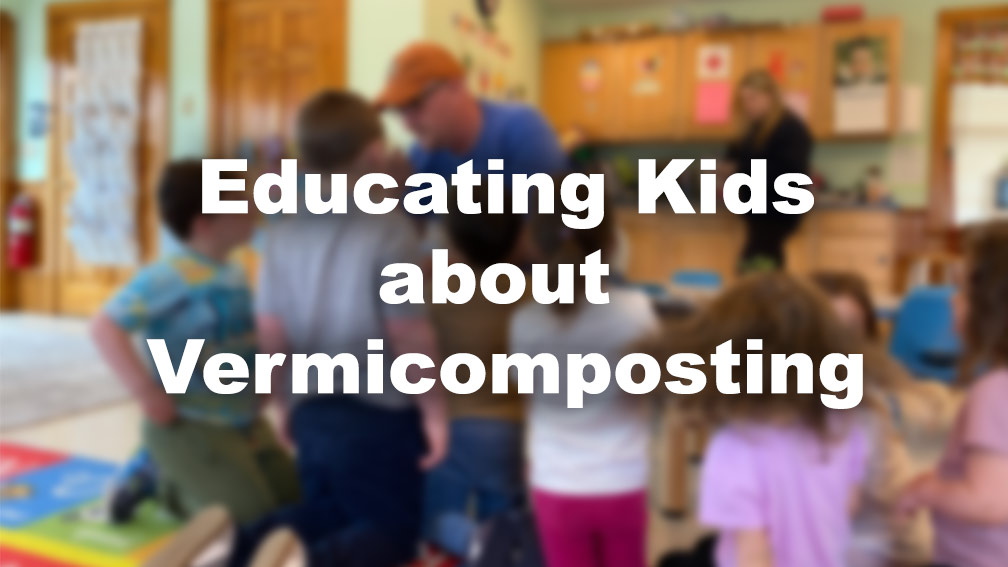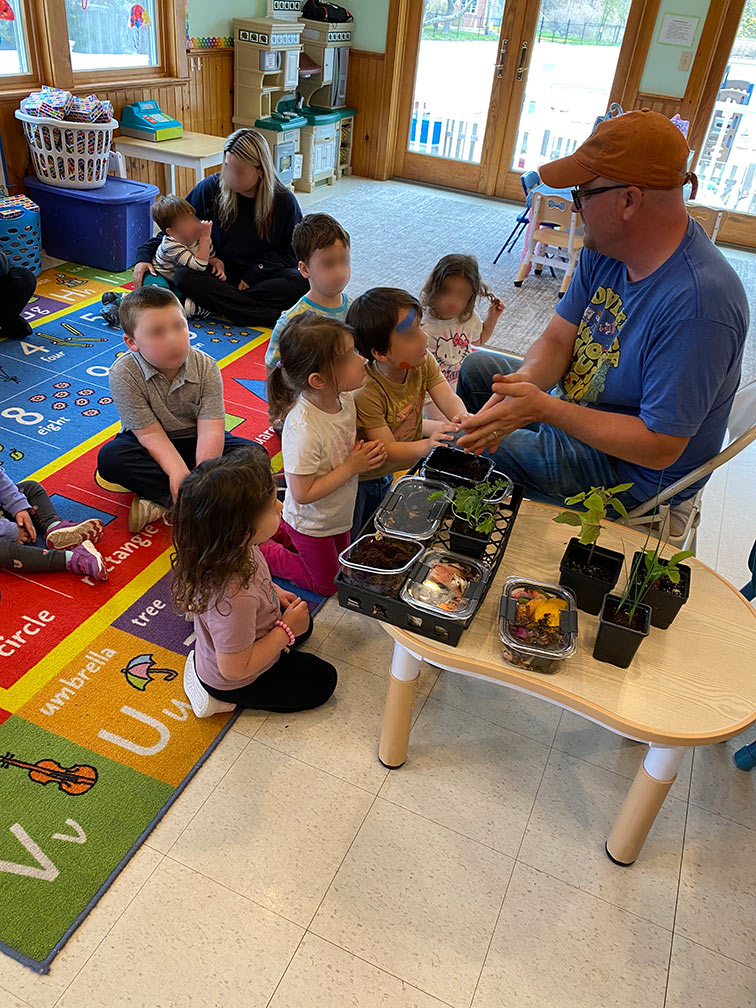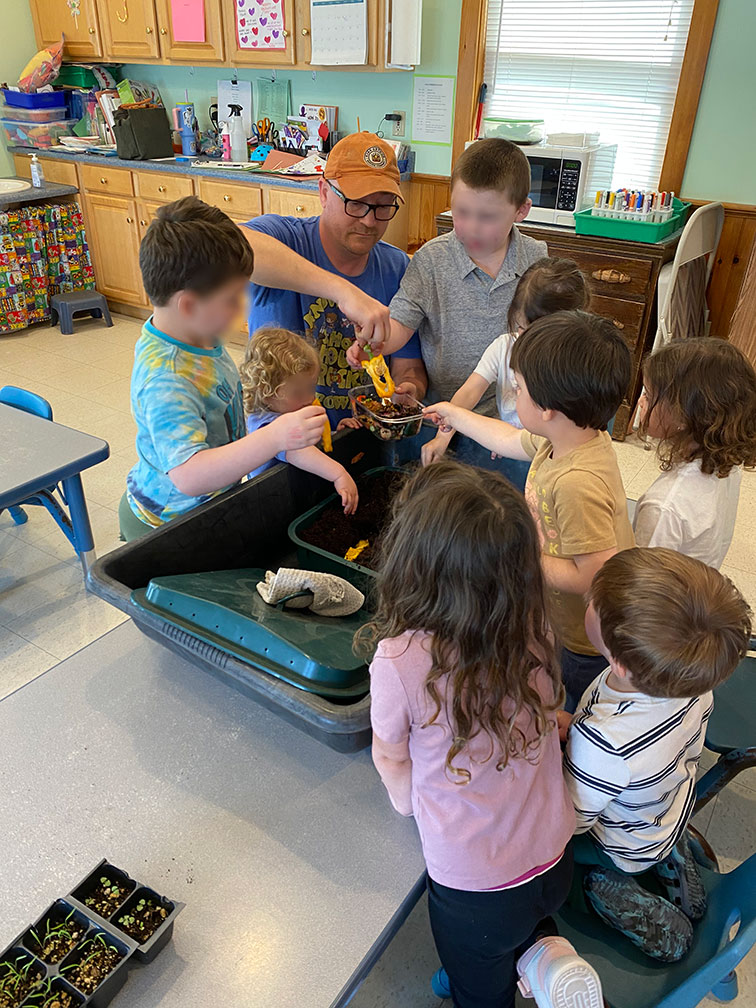Educating Kids about Vermicomposting

TL;DR
It’s never too early to teach kids about natural processes and systems. Here are some things I’ve learned about vermicomposting and what I shared with some pre-school kids this week.
NOTE: all faces but mine have been manually blurred out to respect the privacy of people in the photos.
Context
I was asked to bring in some of my ‘worms’ to show a pre-school class because their learning theme for the past month has been all about spring. I was so happy to help because to me, vermicomposting are one of the best things I’ve learned through in 15 years of gardening. It reduces waste chucked in to the trash bin and produces absolute rocket fuel for your garden.
Before I arrived, they had been talking all about ‘worms’…their role in nature, their anatomy, and experiences had finding worms outside in the past. To keep it approachable for the kids, I chose to bring (in a large tub):
- One undisturbed, mostly ‘finished’ worm tray from the bottom of my stack
- Sealed examples of:
- fresh kitchen scraps that are good for the worms as food (lettuce, kale, carrot peels, apple cores)
- fresh kitchen scraps that are NOT for the worms (onions, garlic, citrus, chicken bones)
- not-so-fresh kitchen scraps (to show the importance of dealing with things quickly)
- fresh worm bedding (in my case, leftover coconut coir)
- finished worm castings (the result of composting)
- some plants in a variety of stages to show as the outcomes of compost-rich soil
- A little chart from our fridge about what does and does not go to the worms as food
What We Did Together
First we had a little ‘circle time’ where I asked them what they already knew about worms. This was fresh in their minds, and we got to talk about the anatomy of a worm as well as other creatures in soil that feed the worms.

We talked about the difference between ‘dirt’ and ‘soil’ and other things like playground sand.
I then showed the different inputs and talked about where some go (to the worms) vs. where others go (to the green compost buckets we see around town). We talked about what worms like and what they don’t like…why they don’t like light and open air and the cold.
We took turns smelling and passing around the containers, though I only cracked the lid on the not-so-fresh for a minute to make everyone go “eeehhhww!”. They all agreed that nothing else was ‘icky’ or ‘smelly’ and said that the worm poop smelled like soil and not like dog or cat or mommy or daddy poops.
Then I went back over, from left-to-right, each of the stages of the inputs and outputs. By this time, I could tell that they wanted to get to the worms. So I cracked open the small container that I had separated some of the worms out into before hand and they ALL crowded in!
Kids Aren’t Afraid of What They Haven’t Been Already Biased To
So many adults I talk to, when hobbies and gardening comes up, have no idea that ‘compost’ isn’t poop and/or that it’s not something that naturally comes in a bag. Now these kids know something different, though it takes reinforcement learnings to really solidify that nature is less icky than what humans tend to do with it.
These days I see so much of the gardening consumerism as similar mindset that results in styrafoam and plastic wrapped boneless skinnless chicken breast in the megamart grocery store. When you grow up thinking that your food comes from ‘the meat department’ or the ‘bread aisle’…when ‘chefs’ only know what arrives on the Sysco truck…when we take pills instead of eat our vegetables…this is all self-inflicted bias against how food is really produced. It’s gentrification in our sustainance.
Kids don’t have these biases until hot dogs and chicken nuggets and fries are reinforced by adults as the easy and comfortable choice. Kids with severe allergies and conditions have even more limited and expensive ‘consumer’ options that the already dulled-down epicurean palette.
I started gardening after a decade of extreme home cooking. My love for cooking came from my upbringing. The more you cook, the more you value high quality produce. Now, after 15 years of gardening, I am interning on a farm to learn how to balance natural systems with scaling them in non-destructive ways.
Well anyway…back to the story…
Then Everyone Fed the Worms
Before we migrated to the bin and worm tray, we talked about the importance of washing hands after handling the vermicompost. Not that it’s dirty, but kids (and adults too) tend to rub their eyes and faces without thinking about it, and that could cause skin irritation given the diversity of compounds in worm castings.

It was a good thing that I brought all my stuff in a large mixing bin because it would have been a mess otherwise.
They were so excited that when one of the kids asked “can we feed them?”, they all started saying it. So I taught them about the ‘trench method’ and they dug little trenches, then took turns putting the fresh veg scraps in and burying them. Trenching helps the worms find and focus on the food as well as improves drainage in a stack. Covering them over with soid so that you never leave fresh scraps uncovered and exposed to air prevents from flies and insects being attracted to the compost setup.
All in all, we spend about 15 minutes talking in circle time and 15 minutes feeding the worms.
Then of course, EVERYONE washed their hands. I got to help a very young, tiny person scrub and rinse too, and it made me nostalgic for days long gone with my own kids.
Packup and leaving was easy. They got to lunch, then afterwards worked on ‘thank you’ notes

Composting is Only Natural
I’ve been vermicomposting for about 13 years now ever since we bought into our first CSA. Despite the harsh New England winter weather, I’ve learned how to over-winter my population of Red Wigglers in a tray system. I care about how much ‘waste’ my household produces, so anything that can’t go to the worms goes to the local compost service bucket, and anything beyond that which can’t be recycled only then goes into the trash bin (mostly plastics at this point).
In the future, I’ll post more on vermicomposting. For now, I think it’s good that the kids got a hands-on (literally) with the worms to normalize that this is what nature does.